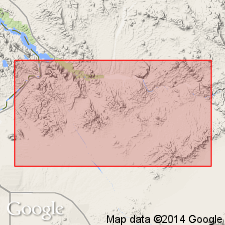
- Usage in publication:
-
- Vampire Formation
- Modifications:
-
- Named
- Dominant lithology:
-
- Conglomerate
- Quartzite
- Sandstone
- Volcanics
- AAPG geologic province:
-
- Plateau sedimentary province
Summary:
Named for the Vampire mine. Type section trends SSW from near center of west edge of sec 12 to east-central part of sec 11, T10N, R17W, Mohave Co, AZ in the Plateau sedimentary province. Reference "sections" are in sec 2, T10N, R17W. Probably correlative with Chinle Formation, Glen Canyon Group, or Entrada Sandstone. Rests unconformably on Buckskin Formation (new). Underlies Planet Volcanics (new). Consists of several to tens of meters of conglomerate at base which is poorly sorted, contains 1) subround to angular clasts of quartzite, quartzose sandstone, vein quartz, and lesser amounts of sandstone, siltstone, phyllite, and quartz pebble conglomerate probably derived from the underlying Buckskin or equivalent rocks, 2) of granite, 3) of volcanic, volcaniclastic and metavolcanic rocks, 4) of quartz and felsite. The basal conglomerate is overlain by 180 to 300 m of quartzite and sandstone, and volcaniclastic rocks that are 180 to 300 m thick. Triassic? and Jurassic age assigned.
Source: GNU records (USGS DDS-6; Denver GNULEX).
For more information, please contact Nancy Stamm, Geologic Names Committee Secretary.
Asterisk (*) indicates published by U.S. Geological Survey authors.
"No current usage" (†) implies that a name has been abandoned or has fallen into disuse. Former usage and, if known, replacement name given in parentheses ( ).
Slash (/) indicates name conflicts with nomenclatural guidelines (CSN, 1933; ACSN, 1961, 1970; NACSN, 1983, 2005, 2021). May be explained within brackets ([ ]).

